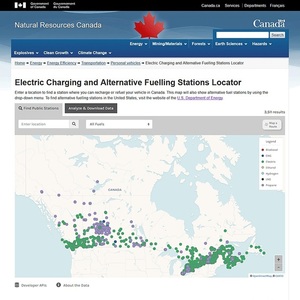NREL, NRCan partner on alternative fueling station locator tool

National Renewable Energy Laboratory
March 13, 2018
BY National Renewable Energy Laboratory
Word of the National Renewable Energy Laboratory's deep transportation web development expertise recently sparked interest in the United States' neighbor to the north, kicking off a collaborative international effort to launch a powerful new alternative fueling station tool on the other side of the border.
NREL teamed up with Natural Resources Canada (NRCan) to create the Electric Charging and Alternative Fuelling Stations Locator, a Canadian version of the lab-developed Alternative Fueling Station Locator. The tool, which is part of a significant investment by the Canadian government to expand the country's electric and alternative fueling infrastructure, ensures drivers and fleets can adopt these fuels with confidence because of newfound access to user-friendly and reliable information about stations offering electric vehicle charging, E85, biodiesel, natural gas, propane, and hydrogen. Within the tool's "Analyze & Download Data" function, the data for Canada can also be queried by geographic location, along a route, by public or private stations, or by payment options.
Advertisement
"This was an exciting and challenging project all around," said Senior Project Lead Rob Eger, who led the development effort on behalf of NREL. "Working with our partners at NRCan, we were able to develop a modern, bilingual web tool that makes it easier for drivers of alternative fuel vehicles to find credible information."
In addition, the Canadian alternative fueling data is now available via the open application programming interface (API) on the NREL Developer Network. This means analysts and web developers anywhere can obtain accurate and trusted data about fueling sites in both Canada and the U.S. The NREL-Canada partnership also signifies a first step in evaluating what capabilities exist for creating a single tool with station information across North America.
Advertisement
"The Canadian tool provides endless opportunities for building out other alternative fuel applications and analyses" said NREL's Johanna Levene, who manages crosscutting Station Locator data programs. "We are already investigating requirements for adding international alternative fuel corridors in the future."
Learn more about NREL's transportation research.
Related Stories
The U.S. Energy Information Administration maintained its forecast for 2025 and 2026 biodiesel, renewable diesel and sustainable aviation fuel (SAF) production in its latest Short-Term Energy Outlook, released July 8.
XCF Global Inc. on July 10 shared its strategic plan to invest close to $1 billion in developing a network of SAF production facilities, expanding its U.S. footprint, and advancing its international growth strategy.
U.S. fuel ethanol capacity fell slightly in April, while biodiesel and renewable diesel capacity held steady, according to data released by the U.S. EIA on June 30. Feedstock consumption was down when compared to the previous month.
XCF Global Inc. on July 8 provided a production update on its flagship New Rise Reno facility, underscoring that the plant has successfully produced SAF, renewable diesel, and renewable naphtha during its initial ramp-up.
The USDA’s Risk Management Agency is implementing multiple changes to the Camelina pilot insurance program for the 2026 and succeeding crop years. The changes will expand coverage options and provide greater flexibility for producers.
Upcoming Events










